Counselling Ethics: Ethical Dilemmas in Dr. Susan Lim's Case Study
VerifiedAdded on 2022/12/27
|7
|2502
|50
Essay
AI Summary
This essay provides a comprehensive analysis of the Dr. Susan Lim case, focusing on the ethical dilemmas she faced regarding inflated charges and breaches of patient confidentiality. It explores the application of counselling ethics, including principles of autonomy, justice, beneficence, and non-maleficence, to the case. The essay examines the 8-step ethical decision model and applies moral theories, particularly the teleological theory, to assess Dr. Lim's actions. It discusses the limitations of the teleological theory in resolving complex moral dilemmas. The conclusion emphasizes the importance of ethical considerations within the medical profession, highlighting the need for more binding regulations to prevent adverse decisions and ensure adherence to ethical standards. The case serves as an example of the potential consequences when ethical boundaries are disregarded, underscoring the significance of ethical conduct in healthcare.
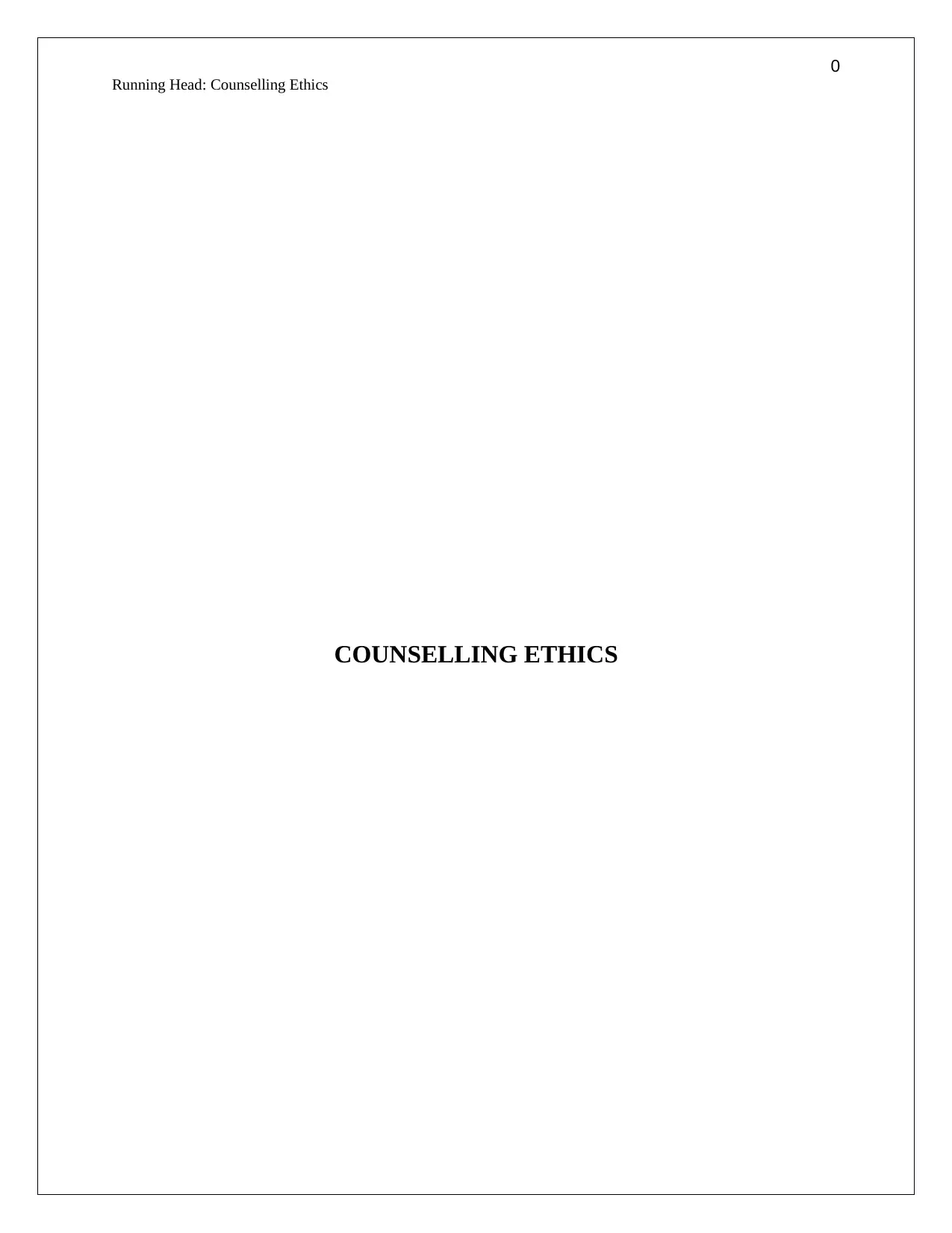
0
Running Head: Counselling Ethics
COUNSELLING ETHICS
Running Head: Counselling Ethics
COUNSELLING ETHICS
Paraphrase This Document
Need a fresh take? Get an instant paraphrase of this document with our AI Paraphraser
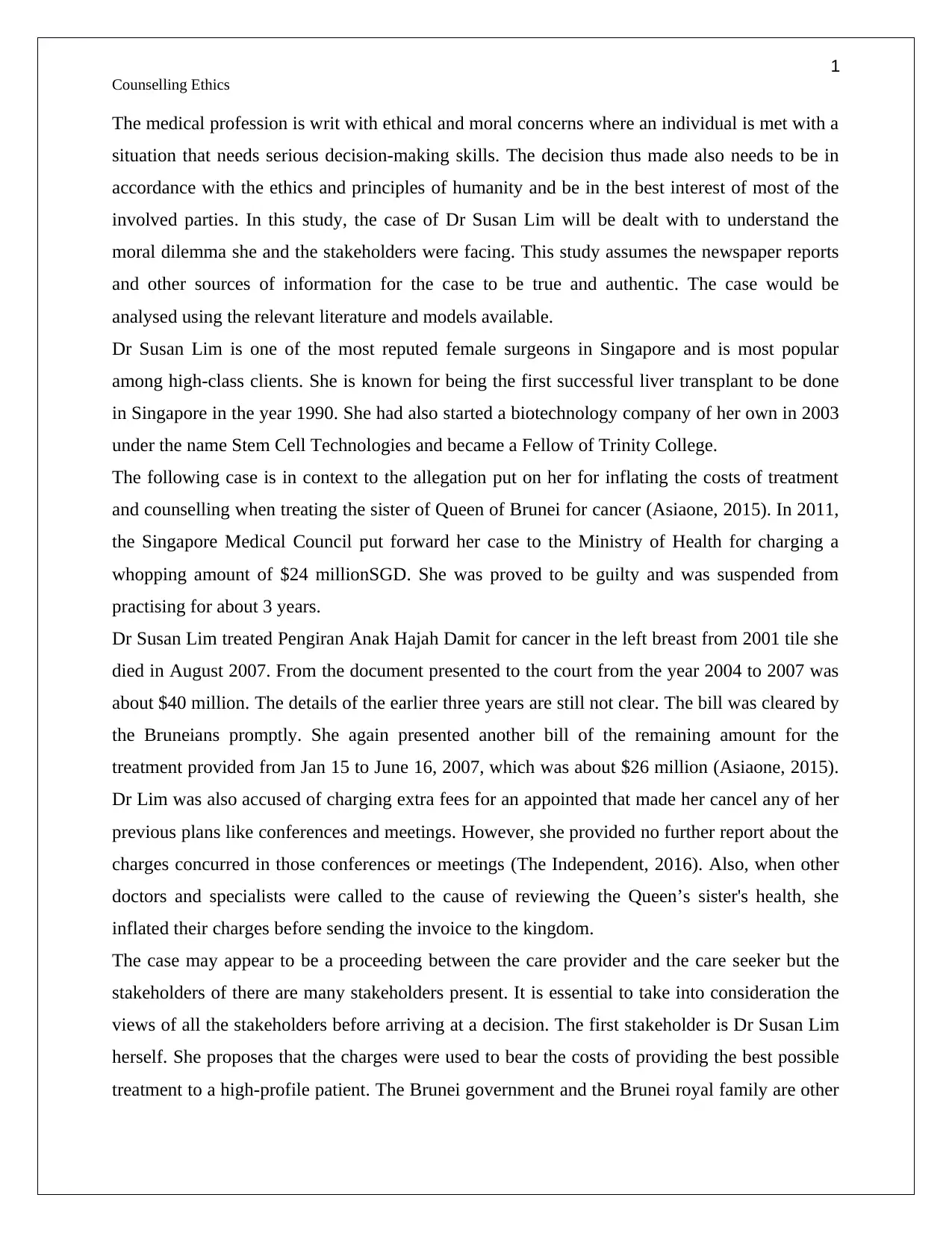
1
Counselling Ethics
The medical profession is writ with ethical and moral concerns where an individual is met with a
situation that needs serious decision-making skills. The decision thus made also needs to be in
accordance with the ethics and principles of humanity and be in the best interest of most of the
involved parties. In this study, the case of Dr Susan Lim will be dealt with to understand the
moral dilemma she and the stakeholders were facing. This study assumes the newspaper reports
and other sources of information for the case to be true and authentic. The case would be
analysed using the relevant literature and models available.
Dr Susan Lim is one of the most reputed female surgeons in Singapore and is most popular
among high-class clients. She is known for being the first successful liver transplant to be done
in Singapore in the year 1990. She had also started a biotechnology company of her own in 2003
under the name Stem Cell Technologies and became a Fellow of Trinity College.
The following case is in context to the allegation put on her for inflating the costs of treatment
and counselling when treating the sister of Queen of Brunei for cancer (Asiaone, 2015). In 2011,
the Singapore Medical Council put forward her case to the Ministry of Health for charging a
whopping amount of $24 millionSGD. She was proved to be guilty and was suspended from
practising for about 3 years.
Dr Susan Lim treated Pengiran Anak Hajah Damit for cancer in the left breast from 2001 tile she
died in August 2007. From the document presented to the court from the year 2004 to 2007 was
about $40 million. The details of the earlier three years are still not clear. The bill was cleared by
the Bruneians promptly. She again presented another bill of the remaining amount for the
treatment provided from Jan 15 to June 16, 2007, which was about $26 million (Asiaone, 2015).
Dr Lim was also accused of charging extra fees for an appointed that made her cancel any of her
previous plans like conferences and meetings. However, she provided no further report about the
charges concurred in those conferences or meetings (The Independent, 2016). Also, when other
doctors and specialists were called to the cause of reviewing the Queen’s sister's health, she
inflated their charges before sending the invoice to the kingdom.
The case may appear to be a proceeding between the care provider and the care seeker but the
stakeholders of there are many stakeholders present. It is essential to take into consideration the
views of all the stakeholders before arriving at a decision. The first stakeholder is Dr Susan Lim
herself. She proposes that the charges were used to bear the costs of providing the best possible
treatment to a high-profile patient. The Brunei government and the Brunei royal family are other
Counselling Ethics
The medical profession is writ with ethical and moral concerns where an individual is met with a
situation that needs serious decision-making skills. The decision thus made also needs to be in
accordance with the ethics and principles of humanity and be in the best interest of most of the
involved parties. In this study, the case of Dr Susan Lim will be dealt with to understand the
moral dilemma she and the stakeholders were facing. This study assumes the newspaper reports
and other sources of information for the case to be true and authentic. The case would be
analysed using the relevant literature and models available.
Dr Susan Lim is one of the most reputed female surgeons in Singapore and is most popular
among high-class clients. She is known for being the first successful liver transplant to be done
in Singapore in the year 1990. She had also started a biotechnology company of her own in 2003
under the name Stem Cell Technologies and became a Fellow of Trinity College.
The following case is in context to the allegation put on her for inflating the costs of treatment
and counselling when treating the sister of Queen of Brunei for cancer (Asiaone, 2015). In 2011,
the Singapore Medical Council put forward her case to the Ministry of Health for charging a
whopping amount of $24 millionSGD. She was proved to be guilty and was suspended from
practising for about 3 years.
Dr Susan Lim treated Pengiran Anak Hajah Damit for cancer in the left breast from 2001 tile she
died in August 2007. From the document presented to the court from the year 2004 to 2007 was
about $40 million. The details of the earlier three years are still not clear. The bill was cleared by
the Bruneians promptly. She again presented another bill of the remaining amount for the
treatment provided from Jan 15 to June 16, 2007, which was about $26 million (Asiaone, 2015).
Dr Lim was also accused of charging extra fees for an appointed that made her cancel any of her
previous plans like conferences and meetings. However, she provided no further report about the
charges concurred in those conferences or meetings (The Independent, 2016). Also, when other
doctors and specialists were called to the cause of reviewing the Queen’s sister's health, she
inflated their charges before sending the invoice to the kingdom.
The case may appear to be a proceeding between the care provider and the care seeker but the
stakeholders of there are many stakeholders present. It is essential to take into consideration the
views of all the stakeholders before arriving at a decision. The first stakeholder is Dr Susan Lim
herself. She proposes that the charges were used to bear the costs of providing the best possible
treatment to a high-profile patient. The Brunei government and the Brunei royal family are other
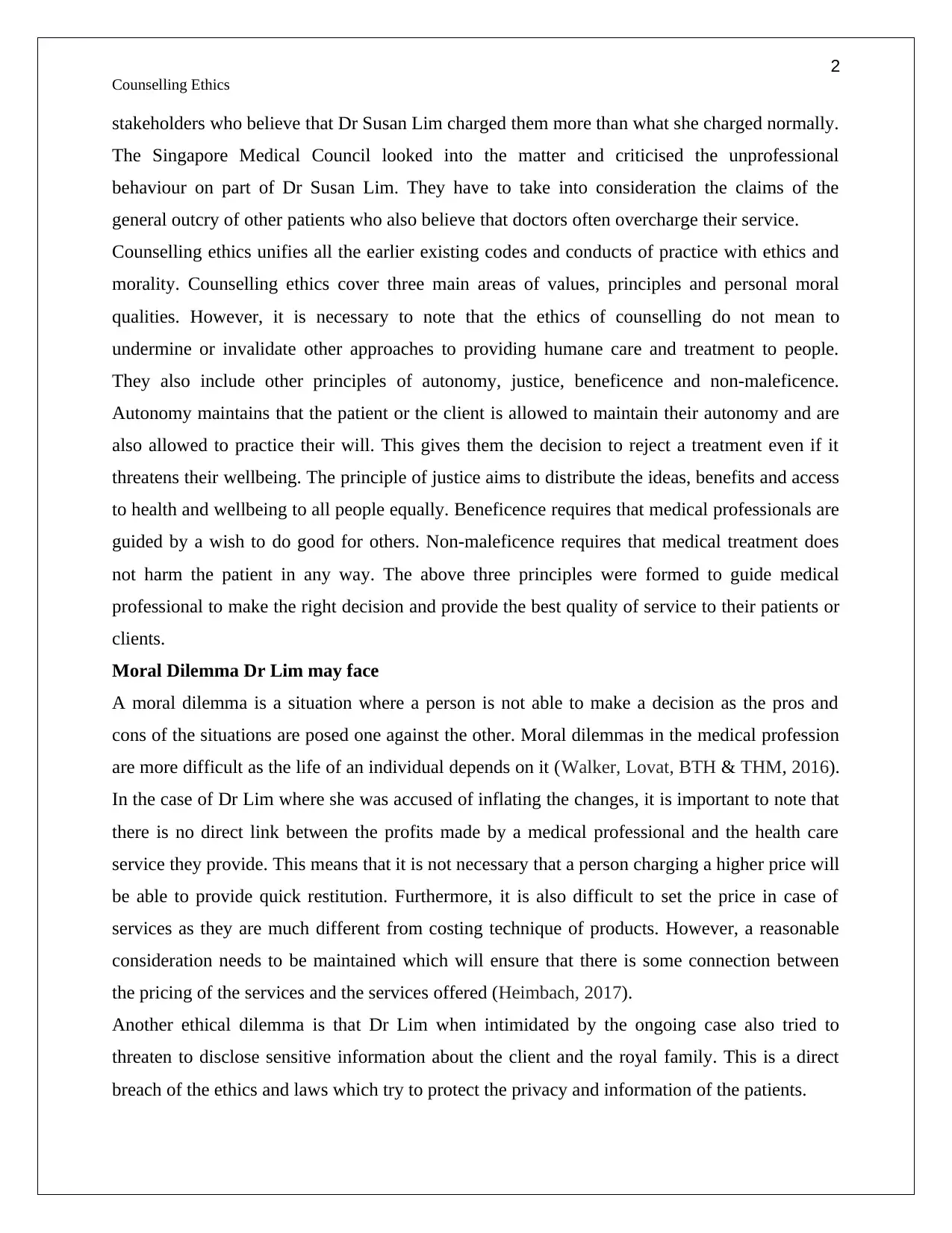
2
Counselling Ethics
stakeholders who believe that Dr Susan Lim charged them more than what she charged normally.
The Singapore Medical Council looked into the matter and criticised the unprofessional
behaviour on part of Dr Susan Lim. They have to take into consideration the claims of the
general outcry of other patients who also believe that doctors often overcharge their service.
Counselling ethics unifies all the earlier existing codes and conducts of practice with ethics and
morality. Counselling ethics cover three main areas of values, principles and personal moral
qualities. However, it is necessary to note that the ethics of counselling do not mean to
undermine or invalidate other approaches to providing humane care and treatment to people.
They also include other principles of autonomy, justice, beneficence and non-maleficence.
Autonomy maintains that the patient or the client is allowed to maintain their autonomy and are
also allowed to practice their will. This gives them the decision to reject a treatment even if it
threatens their wellbeing. The principle of justice aims to distribute the ideas, benefits and access
to health and wellbeing to all people equally. Beneficence requires that medical professionals are
guided by a wish to do good for others. Non-maleficence requires that medical treatment does
not harm the patient in any way. The above three principles were formed to guide medical
professional to make the right decision and provide the best quality of service to their patients or
clients.
Moral Dilemma Dr Lim may face
A moral dilemma is a situation where a person is not able to make a decision as the pros and
cons of the situations are posed one against the other. Moral dilemmas in the medical profession
are more difficult as the life of an individual depends on it (Walker, Lovat, BTH & THM, 2016).
In the case of Dr Lim where she was accused of inflating the changes, it is important to note that
there is no direct link between the profits made by a medical professional and the health care
service they provide. This means that it is not necessary that a person charging a higher price will
be able to provide quick restitution. Furthermore, it is also difficult to set the price in case of
services as they are much different from costing technique of products. However, a reasonable
consideration needs to be maintained which will ensure that there is some connection between
the pricing of the services and the services offered (Heimbach, 2017).
Another ethical dilemma is that Dr Lim when intimidated by the ongoing case also tried to
threaten to disclose sensitive information about the client and the royal family. This is a direct
breach of the ethics and laws which try to protect the privacy and information of the patients.
Counselling Ethics
stakeholders who believe that Dr Susan Lim charged them more than what she charged normally.
The Singapore Medical Council looked into the matter and criticised the unprofessional
behaviour on part of Dr Susan Lim. They have to take into consideration the claims of the
general outcry of other patients who also believe that doctors often overcharge their service.
Counselling ethics unifies all the earlier existing codes and conducts of practice with ethics and
morality. Counselling ethics cover three main areas of values, principles and personal moral
qualities. However, it is necessary to note that the ethics of counselling do not mean to
undermine or invalidate other approaches to providing humane care and treatment to people.
They also include other principles of autonomy, justice, beneficence and non-maleficence.
Autonomy maintains that the patient or the client is allowed to maintain their autonomy and are
also allowed to practice their will. This gives them the decision to reject a treatment even if it
threatens their wellbeing. The principle of justice aims to distribute the ideas, benefits and access
to health and wellbeing to all people equally. Beneficence requires that medical professionals are
guided by a wish to do good for others. Non-maleficence requires that medical treatment does
not harm the patient in any way. The above three principles were formed to guide medical
professional to make the right decision and provide the best quality of service to their patients or
clients.
Moral Dilemma Dr Lim may face
A moral dilemma is a situation where a person is not able to make a decision as the pros and
cons of the situations are posed one against the other. Moral dilemmas in the medical profession
are more difficult as the life of an individual depends on it (Walker, Lovat, BTH & THM, 2016).
In the case of Dr Lim where she was accused of inflating the changes, it is important to note that
there is no direct link between the profits made by a medical professional and the health care
service they provide. This means that it is not necessary that a person charging a higher price will
be able to provide quick restitution. Furthermore, it is also difficult to set the price in case of
services as they are much different from costing technique of products. However, a reasonable
consideration needs to be maintained which will ensure that there is some connection between
the pricing of the services and the services offered (Heimbach, 2017).
Another ethical dilemma is that Dr Lim when intimidated by the ongoing case also tried to
threaten to disclose sensitive information about the client and the royal family. This is a direct
breach of the ethics and laws which try to protect the privacy and information of the patients.
⊘ This is a preview!⊘
Do you want full access?
Subscribe today to unlock all pages.

Trusted by 1+ million students worldwide
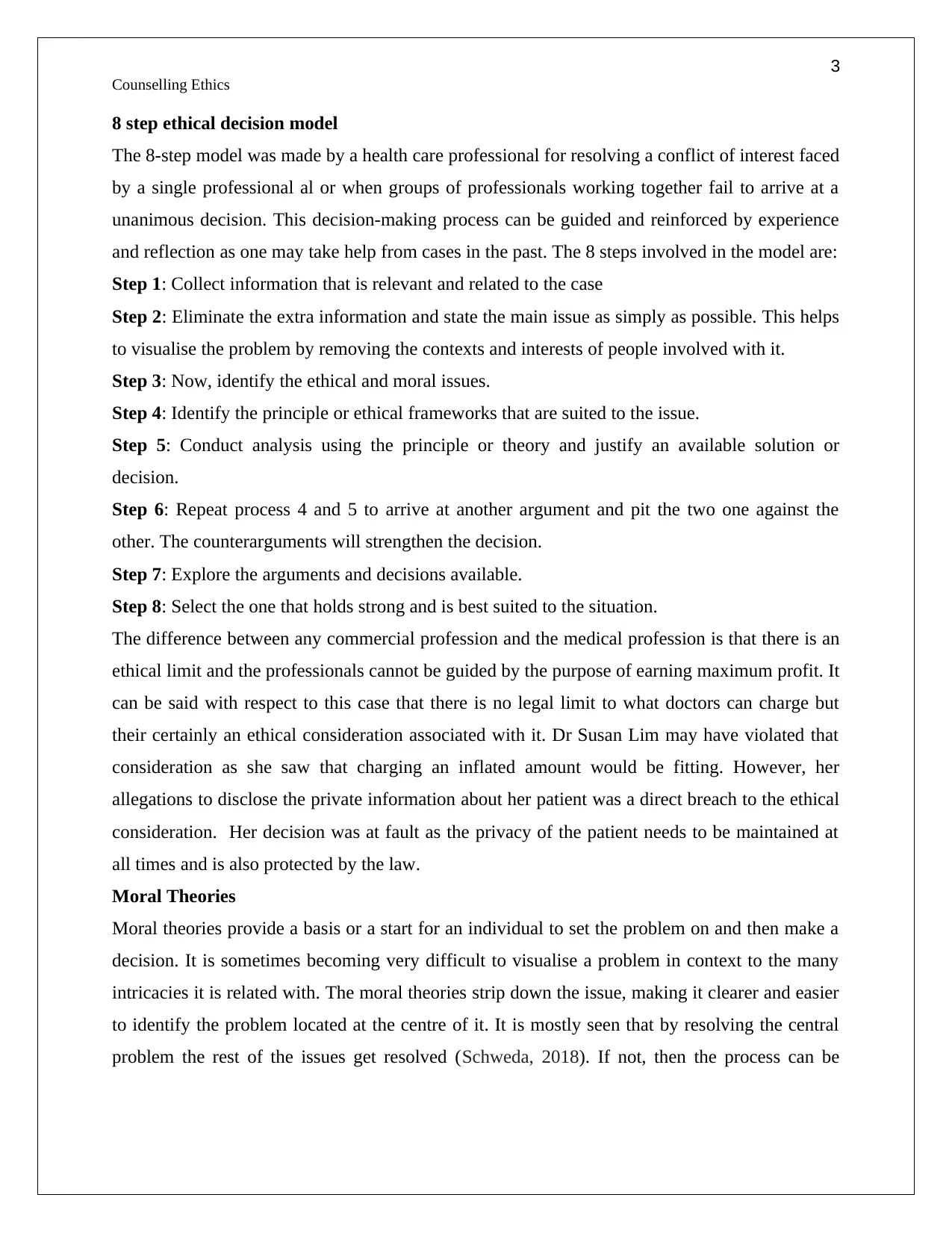
3
Counselling Ethics
8 step ethical decision model
The 8-step model was made by a health care professional for resolving a conflict of interest faced
by a single professional al or when groups of professionals working together fail to arrive at a
unanimous decision. This decision-making process can be guided and reinforced by experience
and reflection as one may take help from cases in the past. The 8 steps involved in the model are:
Step 1: Collect information that is relevant and related to the case
Step 2: Eliminate the extra information and state the main issue as simply as possible. This helps
to visualise the problem by removing the contexts and interests of people involved with it.
Step 3: Now, identify the ethical and moral issues.
Step 4: Identify the principle or ethical frameworks that are suited to the issue.
Step 5: Conduct analysis using the principle or theory and justify an available solution or
decision.
Step 6: Repeat process 4 and 5 to arrive at another argument and pit the two one against the
other. The counterarguments will strengthen the decision.
Step 7: Explore the arguments and decisions available.
Step 8: Select the one that holds strong and is best suited to the situation.
The difference between any commercial profession and the medical profession is that there is an
ethical limit and the professionals cannot be guided by the purpose of earning maximum profit. It
can be said with respect to this case that there is no legal limit to what doctors can charge but
their certainly an ethical consideration associated with it. Dr Susan Lim may have violated that
consideration as she saw that charging an inflated amount would be fitting. However, her
allegations to disclose the private information about her patient was a direct breach to the ethical
consideration. Her decision was at fault as the privacy of the patient needs to be maintained at
all times and is also protected by the law.
Moral Theories
Moral theories provide a basis or a start for an individual to set the problem on and then make a
decision. It is sometimes becoming very difficult to visualise a problem in context to the many
intricacies it is related with. The moral theories strip down the issue, making it clearer and easier
to identify the problem located at the centre of it. It is mostly seen that by resolving the central
problem the rest of the issues get resolved (Schweda, 2018). If not, then the process can be
Counselling Ethics
8 step ethical decision model
The 8-step model was made by a health care professional for resolving a conflict of interest faced
by a single professional al or when groups of professionals working together fail to arrive at a
unanimous decision. This decision-making process can be guided and reinforced by experience
and reflection as one may take help from cases in the past. The 8 steps involved in the model are:
Step 1: Collect information that is relevant and related to the case
Step 2: Eliminate the extra information and state the main issue as simply as possible. This helps
to visualise the problem by removing the contexts and interests of people involved with it.
Step 3: Now, identify the ethical and moral issues.
Step 4: Identify the principle or ethical frameworks that are suited to the issue.
Step 5: Conduct analysis using the principle or theory and justify an available solution or
decision.
Step 6: Repeat process 4 and 5 to arrive at another argument and pit the two one against the
other. The counterarguments will strengthen the decision.
Step 7: Explore the arguments and decisions available.
Step 8: Select the one that holds strong and is best suited to the situation.
The difference between any commercial profession and the medical profession is that there is an
ethical limit and the professionals cannot be guided by the purpose of earning maximum profit. It
can be said with respect to this case that there is no legal limit to what doctors can charge but
their certainly an ethical consideration associated with it. Dr Susan Lim may have violated that
consideration as she saw that charging an inflated amount would be fitting. However, her
allegations to disclose the private information about her patient was a direct breach to the ethical
consideration. Her decision was at fault as the privacy of the patient needs to be maintained at
all times and is also protected by the law.
Moral Theories
Moral theories provide a basis or a start for an individual to set the problem on and then make a
decision. It is sometimes becoming very difficult to visualise a problem in context to the many
intricacies it is related with. The moral theories strip down the issue, making it clearer and easier
to identify the problem located at the centre of it. It is mostly seen that by resolving the central
problem the rest of the issues get resolved (Schweda, 2018). If not, then the process can be
Paraphrase This Document
Need a fresh take? Get an instant paraphrase of this document with our AI Paraphraser
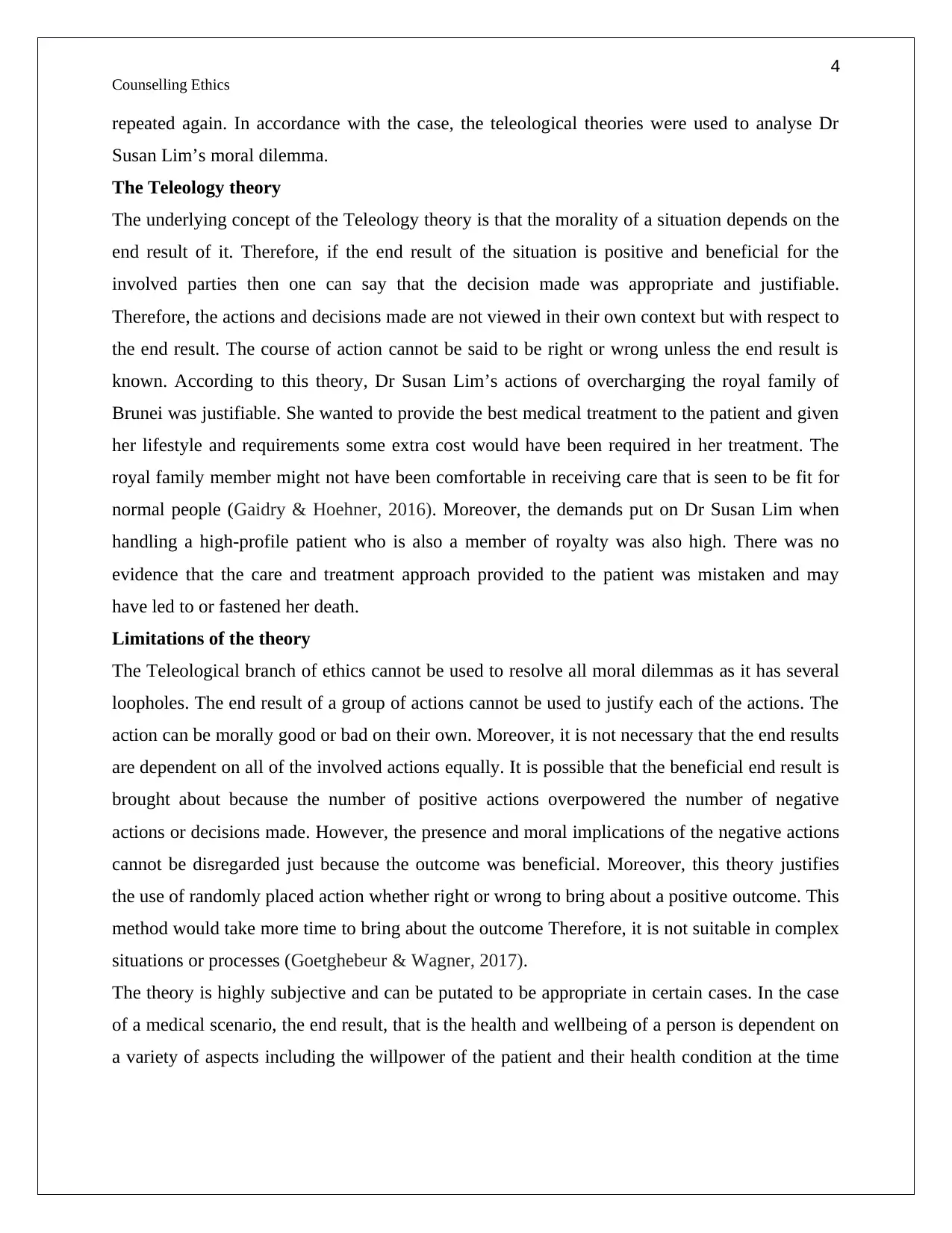
4
Counselling Ethics
repeated again. In accordance with the case, the teleological theories were used to analyse Dr
Susan Lim’s moral dilemma.
The Teleology theory
The underlying concept of the Teleology theory is that the morality of a situation depends on the
end result of it. Therefore, if the end result of the situation is positive and beneficial for the
involved parties then one can say that the decision made was appropriate and justifiable.
Therefore, the actions and decisions made are not viewed in their own context but with respect to
the end result. The course of action cannot be said to be right or wrong unless the end result is
known. According to this theory, Dr Susan Lim’s actions of overcharging the royal family of
Brunei was justifiable. She wanted to provide the best medical treatment to the patient and given
her lifestyle and requirements some extra cost would have been required in her treatment. The
royal family member might not have been comfortable in receiving care that is seen to be fit for
normal people (Gaidry & Hoehner, 2016). Moreover, the demands put on Dr Susan Lim when
handling a high-profile patient who is also a member of royalty was also high. There was no
evidence that the care and treatment approach provided to the patient was mistaken and may
have led to or fastened her death.
Limitations of the theory
The Teleological branch of ethics cannot be used to resolve all moral dilemmas as it has several
loopholes. The end result of a group of actions cannot be used to justify each of the actions. The
action can be morally good or bad on their own. Moreover, it is not necessary that the end results
are dependent on all of the involved actions equally. It is possible that the beneficial end result is
brought about because the number of positive actions overpowered the number of negative
actions or decisions made. However, the presence and moral implications of the negative actions
cannot be disregarded just because the outcome was beneficial. Moreover, this theory justifies
the use of randomly placed action whether right or wrong to bring about a positive outcome. This
method would take more time to bring about the outcome Therefore, it is not suitable in complex
situations or processes (Goetghebeur & Wagner, 2017).
The theory is highly subjective and can be putated to be appropriate in certain cases. In the case
of a medical scenario, the end result, that is the health and wellbeing of a person is dependent on
a variety of aspects including the willpower of the patient and their health condition at the time
Counselling Ethics
repeated again. In accordance with the case, the teleological theories were used to analyse Dr
Susan Lim’s moral dilemma.
The Teleology theory
The underlying concept of the Teleology theory is that the morality of a situation depends on the
end result of it. Therefore, if the end result of the situation is positive and beneficial for the
involved parties then one can say that the decision made was appropriate and justifiable.
Therefore, the actions and decisions made are not viewed in their own context but with respect to
the end result. The course of action cannot be said to be right or wrong unless the end result is
known. According to this theory, Dr Susan Lim’s actions of overcharging the royal family of
Brunei was justifiable. She wanted to provide the best medical treatment to the patient and given
her lifestyle and requirements some extra cost would have been required in her treatment. The
royal family member might not have been comfortable in receiving care that is seen to be fit for
normal people (Gaidry & Hoehner, 2016). Moreover, the demands put on Dr Susan Lim when
handling a high-profile patient who is also a member of royalty was also high. There was no
evidence that the care and treatment approach provided to the patient was mistaken and may
have led to or fastened her death.
Limitations of the theory
The Teleological branch of ethics cannot be used to resolve all moral dilemmas as it has several
loopholes. The end result of a group of actions cannot be used to justify each of the actions. The
action can be morally good or bad on their own. Moreover, it is not necessary that the end results
are dependent on all of the involved actions equally. It is possible that the beneficial end result is
brought about because the number of positive actions overpowered the number of negative
actions or decisions made. However, the presence and moral implications of the negative actions
cannot be disregarded just because the outcome was beneficial. Moreover, this theory justifies
the use of randomly placed action whether right or wrong to bring about a positive outcome. This
method would take more time to bring about the outcome Therefore, it is not suitable in complex
situations or processes (Goetghebeur & Wagner, 2017).
The theory is highly subjective and can be putated to be appropriate in certain cases. In the case
of a medical scenario, the end result, that is the health and wellbeing of a person is dependent on
a variety of aspects including the willpower of the patient and their health condition at the time
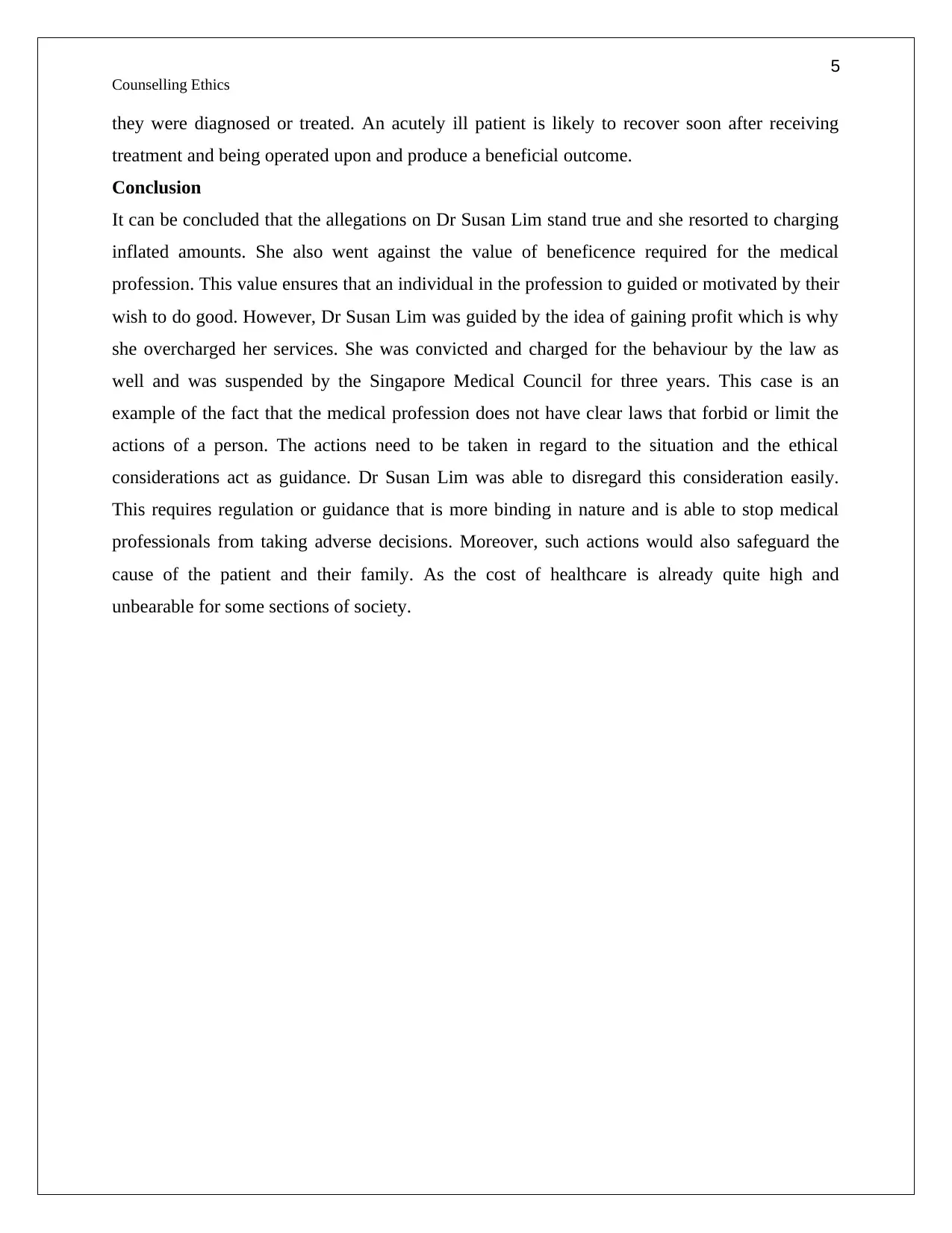
5
Counselling Ethics
they were diagnosed or treated. An acutely ill patient is likely to recover soon after receiving
treatment and being operated upon and produce a beneficial outcome.
Conclusion
It can be concluded that the allegations on Dr Susan Lim stand true and she resorted to charging
inflated amounts. She also went against the value of beneficence required for the medical
profession. This value ensures that an individual in the profession to guided or motivated by their
wish to do good. However, Dr Susan Lim was guided by the idea of gaining profit which is why
she overcharged her services. She was convicted and charged for the behaviour by the law as
well and was suspended by the Singapore Medical Council for three years. This case is an
example of the fact that the medical profession does not have clear laws that forbid or limit the
actions of a person. The actions need to be taken in regard to the situation and the ethical
considerations act as guidance. Dr Susan Lim was able to disregard this consideration easily.
This requires regulation or guidance that is more binding in nature and is able to stop medical
professionals from taking adverse decisions. Moreover, such actions would also safeguard the
cause of the patient and their family. As the cost of healthcare is already quite high and
unbearable for some sections of society.
Counselling Ethics
they were diagnosed or treated. An acutely ill patient is likely to recover soon after receiving
treatment and being operated upon and produce a beneficial outcome.
Conclusion
It can be concluded that the allegations on Dr Susan Lim stand true and she resorted to charging
inflated amounts. She also went against the value of beneficence required for the medical
profession. This value ensures that an individual in the profession to guided or motivated by their
wish to do good. However, Dr Susan Lim was guided by the idea of gaining profit which is why
she overcharged her services. She was convicted and charged for the behaviour by the law as
well and was suspended by the Singapore Medical Council for three years. This case is an
example of the fact that the medical profession does not have clear laws that forbid or limit the
actions of a person. The actions need to be taken in regard to the situation and the ethical
considerations act as guidance. Dr Susan Lim was able to disregard this consideration easily.
This requires regulation or guidance that is more binding in nature and is able to stop medical
professionals from taking adverse decisions. Moreover, such actions would also safeguard the
cause of the patient and their family. As the cost of healthcare is already quite high and
unbearable for some sections of society.
⊘ This is a preview!⊘
Do you want full access?
Subscribe today to unlock all pages.

Trusted by 1+ million students worldwide
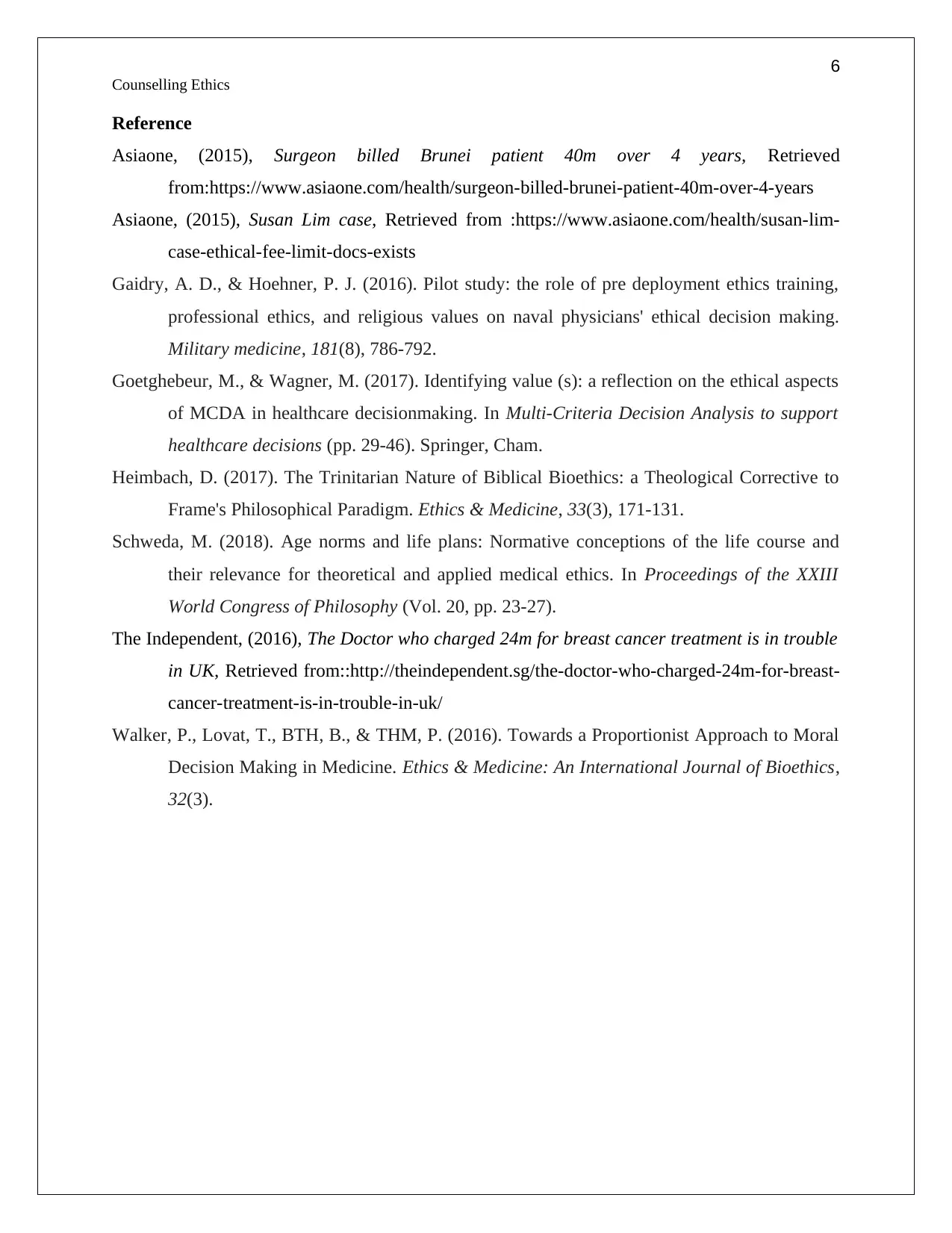
6
Counselling Ethics
Reference
Asiaone, (2015), Surgeon billed Brunei patient 40m over 4 years, Retrieved
from:https://www.asiaone.com/health/surgeon-billed-brunei-patient-40m-over-4-years
Asiaone, (2015), Susan Lim case, Retrieved from :https://www.asiaone.com/health/susan-lim-
case-ethical-fee-limit-docs-exists
Gaidry, A. D., & Hoehner, P. J. (2016). Pilot study: the role of pre deployment ethics training,
professional ethics, and religious values on naval physicians' ethical decision making.
Military medicine, 181(8), 786-792.
Goetghebeur, M., & Wagner, M. (2017). Identifying value (s): a reflection on the ethical aspects
of MCDA in healthcare decisionmaking. In Multi-Criteria Decision Analysis to support
healthcare decisions (pp. 29-46). Springer, Cham.
Heimbach, D. (2017). The Trinitarian Nature of Biblical Bioethics: a Theological Corrective to
Frame's Philosophical Paradigm. Ethics & Medicine, 33(3), 171-131.
Schweda, M. (2018). Age norms and life plans: Normative conceptions of the life course and
their relevance for theoretical and applied medical ethics. In Proceedings of the XXIII
World Congress of Philosophy (Vol. 20, pp. 23-27).
The Independent, (2016), The Doctor who charged 24m for breast cancer treatment is in trouble
in UK, Retrieved from::http://theindependent.sg/the-doctor-who-charged-24m-for-breast-
cancer-treatment-is-in-trouble-in-uk/
Walker, P., Lovat, T., BTH, B., & THM, P. (2016). Towards a Proportionist Approach to Moral
Decision Making in Medicine. Ethics & Medicine: An International Journal of Bioethics,
32(3).
Counselling Ethics
Reference
Asiaone, (2015), Surgeon billed Brunei patient 40m over 4 years, Retrieved
from:https://www.asiaone.com/health/surgeon-billed-brunei-patient-40m-over-4-years
Asiaone, (2015), Susan Lim case, Retrieved from :https://www.asiaone.com/health/susan-lim-
case-ethical-fee-limit-docs-exists
Gaidry, A. D., & Hoehner, P. J. (2016). Pilot study: the role of pre deployment ethics training,
professional ethics, and religious values on naval physicians' ethical decision making.
Military medicine, 181(8), 786-792.
Goetghebeur, M., & Wagner, M. (2017). Identifying value (s): a reflection on the ethical aspects
of MCDA in healthcare decisionmaking. In Multi-Criteria Decision Analysis to support
healthcare decisions (pp. 29-46). Springer, Cham.
Heimbach, D. (2017). The Trinitarian Nature of Biblical Bioethics: a Theological Corrective to
Frame's Philosophical Paradigm. Ethics & Medicine, 33(3), 171-131.
Schweda, M. (2018). Age norms and life plans: Normative conceptions of the life course and
their relevance for theoretical and applied medical ethics. In Proceedings of the XXIII
World Congress of Philosophy (Vol. 20, pp. 23-27).
The Independent, (2016), The Doctor who charged 24m for breast cancer treatment is in trouble
in UK, Retrieved from::http://theindependent.sg/the-doctor-who-charged-24m-for-breast-
cancer-treatment-is-in-trouble-in-uk/
Walker, P., Lovat, T., BTH, B., & THM, P. (2016). Towards a Proportionist Approach to Moral
Decision Making in Medicine. Ethics & Medicine: An International Journal of Bioethics,
32(3).
1 out of 7
Your All-in-One AI-Powered Toolkit for Academic Success.
+13062052269
info@desklib.com
Available 24*7 on WhatsApp / Email
![[object Object]](/_next/static/media/star-bottom.7253800d.svg)
Unlock your academic potential
Copyright © 2020–2025 A2Z Services. All Rights Reserved. Developed and managed by ZUCOL.

